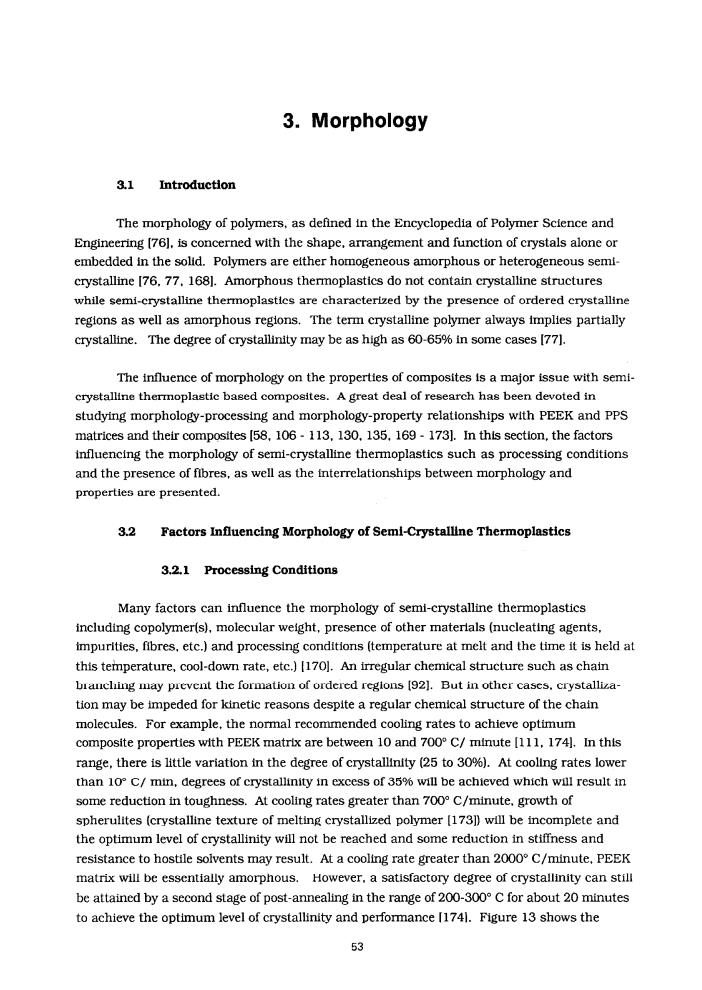正在加载图片...

3.Morphology 3.1 Introduction The morphology of polymers,as defined in the Encyclopedia of Polymer Science and Engineering [761,is concerned with the shape,arrangement and function of crystals alone or embedded in the solid.Polymers are either homogeneous amorphous or heterogeneous semi- crystalline [76.77.1681.Amorphous thermoplastics do not contain crystalline structures while semi-crystalline thermoplastics are characterized by the presence of ordered crystalline regions as well as amorphous regions.The term crystalline polymer always implies partially crystalline.The degree of crystallinity may be as high as 60-65%in some cases [771. The influence of morphology on the properties of composites is a major issue with semi- crystalline thermoplastic based composites.A great deal of research has been devoted in studying morphology-processing and morphology-property relationships with PEEK and PPS matrices and their composites [58,106-113,130.135.169-173].In this section,the factors influencing the morphology of semi-crystalline thermoplastics such as processing conditions and the presence of fbres,as well as the interrelationships between morphology and properties are presented. 3.2 Factors Influencing Morphology of Semi-Crystalline Thermoplastics 3.2.1 Processing Conditions Many factors can influence the morphology of semi-crystalline thermoplastics including copolymer(s),molecular weight,presence of other materlals (nucleating agents. impurities,fibres,etc.)and processing conditions(temperature at melt and the time it is held at this temperature,cool-down rate,etc.)[170].An irregular chemical structure such as chain biaucling may prevent the formation of ordered regions [921.But in other cases.crystalliza- tion may be impeded for kinetic reasons despite a regular chemical structure of the chain molecules.For example,the normal recommended cooling rates to achieve optimum composite properties with PEEK matrix are between 10 and 700C/minute [111,174).In this range,there is little variation in the degree of crystallinity (25 to 30%).At coollng rates lower than 10 C/min,degrees of crystallinity in excess of 35%will be achieved which wul result in some reduction in toughness.At cooling rates greater than 700C/minute.growth of spherulites (crystalline texture of melting crystallized polymer [173))will be incomplete and the optimum level of crystallinity will not be reached and some reduction in stiffness and resistance to hostile solvents may result.At a cooling rate greater than 2000C/minute.PEEK matrix will be essentially amorphous.However.a satisfactory degree of crystallinity can still be attained by a second stage of post-annealing in the range of 200-300C for about 20 minutes to achieve the optimum level of crystallinity and performance 11741.Figure 13 shows the 533. Morphology 3.1 Introduction The morphology of polymers, as defined in the Encyclopedia of Polymer Science and Engineering [76]. is concerned with the shape, arrangement and function of crystals alone or embedded in the soltd. Polymers are either homogeneous amorphous or heterogeneous semicrystalline [76. 77. 1681. Amorphous thermoplastics do not contain crystalline structures while semi-crystalline thermoplastics are characterized by the presence of ordered crystalline regions as well as amorphous regions. The term crystalline polymer always implies partially crystalline. The degree of crystahinity may be as high as 60-65% in some cases [77]. The influence of morphology on the properties of composites is a major issue with semicrystalline thermoplastic based composites. A great deal of research has been devoted in studying morphology-processing and morphology-property relationships with PEEK and PPS matrices and their composites [58, 106 - 113, 130, 135, 169 - 1731. In this section, the factors influencing the morphology of semi-crystalline thermoplastics such as processing conditions and the presence of fibres. as well as the interrelationships between morphology and properties are presented. 3.2 Factors Influencing Morphology of Semi-Crystalline Thermoplastics 3.2.1 Processing Conditions Many factors can influence the morphology of semi-crystalline thermoplastics including copolymer(s), molecular weight, presence of other materials (nucleating agents, impurities, fibres, etc.) and processing conditions (temperature at melt and the time it is held at this temperature, cool-down rate, etc.) (1701. An irregular chemical structure such as chain branching may prevent the formation of ordered regions 1921. But in other cases, crystallization may be impeded for kinetic reasons despite a regular chemical structure of the chain molecules. For example, the normal recommended cooling rates to achieve optimum composite properties with PEEK matrix are between 10 and 700” C/ minute [ 111. 1741. In this range, there is little variation in the degree of crystallinity (25 to 30%). At cooling rates lower than 10” C/ mtn. degrees of crystallinity in excess of 35% will be achieved which will result in some reduction in toughness. At cooling rates greater than 700” C/minute, growth of spherulites (crystalline texture of melting crystallized polymer [173]) will be incomplete and the optimum level of crystallinity will not be reached and some reduction in stiffness and resistance to hostile solvents may result. At a cooling rate greater than 2000’ C/minute, PEEK matrix will be essentially amorphous. However, a satisfactory degree of crystallinity can still be attained by a second stage of post-annealing in the range of 200-300” C for about 20 minutes to achieve the optimum level of crystallinity and performance [174]. Figure 13 shows the 53